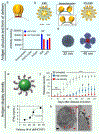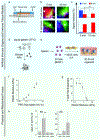Biomaterials as Tools to Decode Immunity
- PMID: 31782844
- PMCID: PMC7124992
- DOI: 10.1002/adma.201903367
Biomaterials as Tools to Decode Immunity
Abstract
The immune system has remarkable capabilities to combat disease with exquisite selectivity. This feature has enabled vaccines that provide protection for decades and, more recently, advances in immunotherapies that can cure some cancers. Greater control over how immune signals are presented, delivered, and processed will help drive even more powerful options that are also safe. Such advances will be underpinned by new tools that probe how immune signals are integrated by immune cells and tissues. Biomaterials are valuable resources to support this goal, offering robust, tunable properties. The growing role of biomaterials as tools to dissect immune function in fundamental and translational contexts is highlighted. These technologies can serve as tools to understand the immune system across molecular, cellular, and tissue length scales. A common theme is exploiting biomaterial features to rationally direct how specific immune cells or organs encounter a signal. This precision strategy, enabled by distinct material properties, allows isolation of immunological parameters or processes in a way that is challenging with conventional approaches. The utility of these capabilities is demonstrated through examples in vaccines for infectious disease and cancer immunotherapy, as well as settings of immune regulation that include autoimmunity and transplantation.
Keywords: immunology; immunotherapy; microparticles; nanoparticles; organ-on-a-chip; organoids.
© 2019 WILEY-VCH Verlag GmbH & Co. KGaA, Weinheim.
Figures





Similar articles
-
Harnessing Biomaterials to Study and Direct Antigen-Specific Immunotherapy.ACS Appl Bio Mater. 2023 Jun 19;6(6):2017-2028. doi: 10.1021/acsabm.3c00136. Epub 2023 Apr 17. ACS Appl Bio Mater. 2023. PMID: 37068126 Free PMC article. Review.
-
Self-Assembly as a Molecular Strategy to Improve Immunotherapy.Acc Chem Res. 2020 Nov 17;53(11):2534-2545. doi: 10.1021/acs.accounts.0c00438. Epub 2020 Oct 19. Acc Chem Res. 2020. PMID: 33074649 Free PMC article.
-
Biomaterials-Mediated Engineering of the Immune System.Annu Rev Immunol. 2023 Apr 26;41:153-179. doi: 10.1146/annurev-immunol-101721-040259. Epub 2023 Jan 25. Annu Rev Immunol. 2023. PMID: 36696570 Free PMC article. Review.
-
Engineering self-assembled materials to study and direct immune function.Adv Drug Deliv Rev. 2017 May 15;114:60-78. doi: 10.1016/j.addr.2017.03.005. Epub 2017 Apr 6. Adv Drug Deliv Rev. 2017. PMID: 28392305 Free PMC article. Review.
-
Biomaterials as Local Niches for Immunomodulation.Acc Chem Res. 2020 Sep 15;53(9):1749-1760. doi: 10.1021/acs.accounts.0c00341. Epub 2020 Aug 13. Acc Chem Res. 2020. PMID: 32786230
Cited by
-
Interactions of Cells and Biomaterials for Nerve Tissue Engineering: Polymers and Fabrication.Polymers (Basel). 2023 Sep 7;15(18):3685. doi: 10.3390/polym15183685. Polymers (Basel). 2023. PMID: 37765540 Free PMC article. Review.
-
Emerging Adjuvants for Cancer Immunotherapy.Front Chem. 2020 Jul 30;8:601. doi: 10.3389/fchem.2020.00601. eCollection 2020. Front Chem. 2020. PMID: 32850636 Free PMC article. Review.
-
Spatial delivery of immune cues to lymph nodes to define therapeutic outcomes in cancer vaccination.Biomater Sci. 2022 Aug 9;10(16):4612-4626. doi: 10.1039/d2bm00403h. Biomater Sci. 2022. PMID: 35796247 Free PMC article.
-
Mapping the Mechanical and Immunological Profiles of Polymeric Microneedles to Enable Vaccine and Immunotherapy Applications.Front Immunol. 2022 Mar 14;13:843355. doi: 10.3389/fimmu.2022.843355. eCollection 2022. Front Immunol. 2022. PMID: 35359943 Free PMC article.
-
Supramolecular Biomaterials for Cancer Immunotherapy.Research (Wash D C). 2023 Sep 12;6:0211. doi: 10.34133/research.0211. eCollection 2023. Research (Wash D C). 2023. PMID: 37705962 Free PMC article. Review.
References
Publication types
MeSH terms
Substances
Grants and funding
LinkOut - more resources
Full Text Sources

